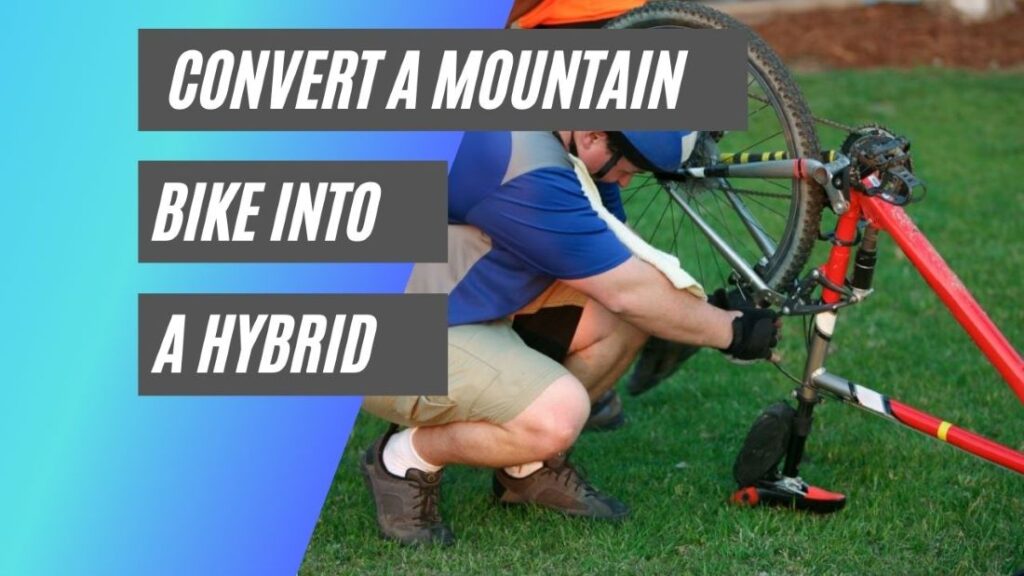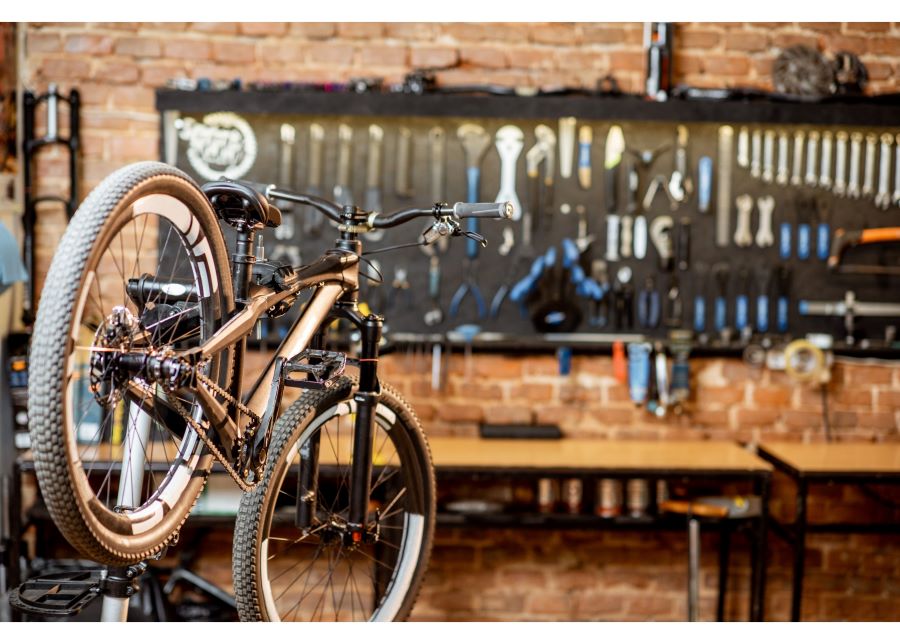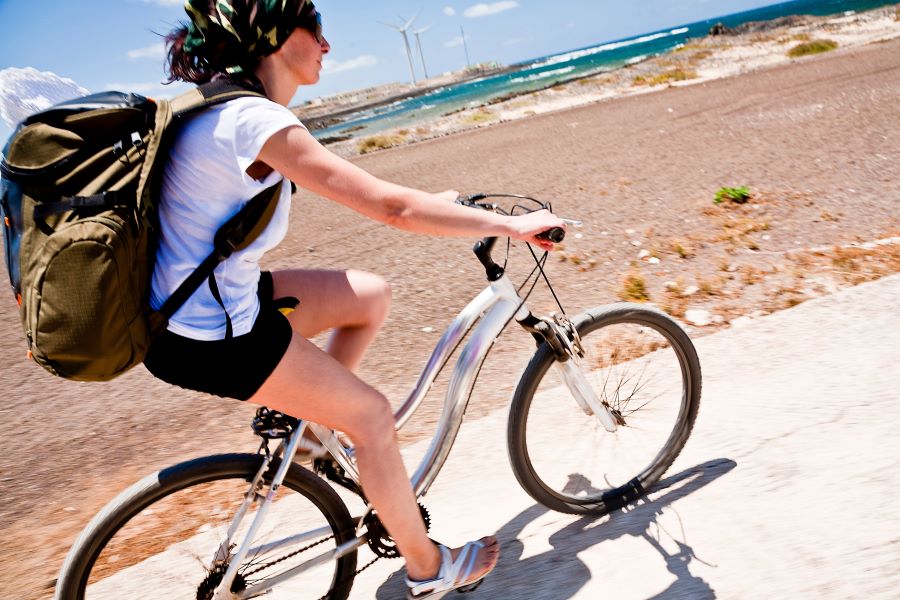This post may contain affiliate links. If you click an affiliate link and make a purchase, I may earn a commission. Also, as an Amazon Associate, I earn from qualifying purchases.--
It’s actually pretty simple to convert a mountain bike into a hybrid, and in this post, I’ll look at exactly how to do it.
There are nine simple steps to follow which are:
Step | Action | Technical difficulty |
| Step 1 | Adjust the suspensions | Medium difficulty |
| Step 2 | Install new tires and wheels | Medium difficulty |
| Step 3 | Pump up the tire pressure | Easy |
| Step 4 | Change the gearing | Hard |
| Step 5 | Change the saddle position | Easy |
| Step 6 | Install lights and reflectors | Easy |
| Step 7 | Install mud flaps and fenders | Medium difficulty |
| Step 8 | Change the pedals | Easy |
| Step 9 | Change the handlebar design | Easy |
This system is particularly for anyone looking to take their mountain bike out on the road. Sure, you could have two bikes – one hybrid and one mountain bike.
But if budget is an issue, and you just want the one bike, then in this article I’ll run you through how you can convert your mountain bike into a hybrid bike in nine simple steps that are super easy to do at home and will help you save up on tons of money.

Why Might You Want To Change A Mountain Bike Into A Hybrid?
Just based on face value, both mountain and hybrid bikes can look quite similar. Both of these bikes have a similar geometry with handlebars, flat tires, and disc brakes.
However, to the discerning cyclist, the differences between these two bikes are very distinct.
Mountain vs. Hybrid Bike
With tires wider than two inches, wide-range drivetrains, and hydraulic disc brakes, mountain bikes are best suited for handling steep climbs and descents on technical terrains.
These bikes are equipped with powerful brakes and large wheels that can endure long rides in off-road areas through rocky roads and mountain trails. (Source)
However, with thick rugged tires and a stainless steel framework, mountain bikes are incredibly heavy, not suitable for long commutes on lighter roads. If you’ve ever commuted to someplace on a mountain bike, you must already know why these bikes are not considered efficient commuters.
On the other hand, hybrid bikes are designed for city riding along broken roads and semi-steeped trails.
Commonly used for commuting and recreational riding, these bikes have smoother tires and are lighter in weight allowing you to gain better speed while touring on roads that are less sturdy than those designated for mountain bikes.
How to Convert Your Mountain Bike into a Hybrid Bike
With the right guidance and proper tools, converting a mountain bike into a hybrid bike is extremely easy. Follow these nine simple steps to turn your mountain bike into the perfect hybrid bike fit for a ride on the road.
Step 1: Adjust the Suspensions
If you want to make your mountain bike more suitable for a ride on the road like a hybrid bike, you must start by reducing the factors that make it suitable for riding off the road on mountainous terrains.
And one of the factors that play an essential role in ensuring stability to your mountain bike on a rocky and mountainous climb is the suspension that helps to absorb impact from rocks and the rugged terrain.
However, you don’t need these suspensions if you’re cycling on the road.
In fact, getting rid of them can make your bike much lighter and more comfortable for you to ride on smoother roads.
Additionally, bobbing while pedaling can be extremely taxing and can drain all your energy. Swap out your suspension fork and replace it with a rigid one to make your ride lighter and stiffer.
The suspension forks on some modern mountain bikes can also be locked out, which forms a simple and convenient adjustment when converting your mountain bike into a hybrid one.
This lockout design is particularly useful if you cannot afford to buy new rigid forks or if you plan on venturing off-road every now and then. Gently pull on the lever and simply lock out the suspension to reduce all that resistance that can hold you back.
The same concept applies to rear suspensions as well. If your bike has a lockout design, then lock it out. However, if it does not, you can also pump up the air pressure inside to stiffen them and get rid of as much sag as you can.

Step 2: Install New Tires and Wheels
Once you’ve dealt with the suspensions of your mountain bike, it’s now time to handle the wheels and tires.
The tires of a mountain bike have very thick aggressive treads that provide a mechanical grip that allows them to handle challenging trails and makes cruising on off-road rugged terrains easy.
However, the traction offered when the knobs of these tires dig into the dirt is not suitable for a hybrid bike. They not only offer unnecessary resistance but also make it much more difficult to pedal; draining your power.
If the tires on your bike are wearing out, this is the perfect opportunity for you to replace them.
I suggest that you replace the tires on your mountain bike with slicker and narrower tires that don’t offer the same level of grip that a mountain bike does.
These tires are much more efficient for traveling on lighter roads because they reduce rolling resistance and do not provide a strong mechanical grip on the road. Search for 1.5-inch tires that are slick and fit your wheels.
If you can’t find slick tires that fit your wheels or anticipate going on the road a lot on your mountain bike, you should also consider installing a new set of wheels too.
First, take the tire off and use an adjustable wrench to loosen the nuts on the hub. Then replace your wheels with new ones that match the size of your fork and also your new tires.
Once replaced, use the adjustable wrench to tighten the nuts again and use an Allen wrench to tighten the spokes.
Always remember to update your emergency toolkit according to the newly installed tires and wheels so that you have the appropriate tools when needed.
Step 3: Pump Up the Tire Pressure
The tires on a mountain bike have a low-pressure design that reduces your speed by increasing the surface area of the part of the tire that is in contact with the ground.
The low pressure increases rolling resistance which is especially useful when riding downhill. However, this low tire pressure is useless for a hybrid bike.
The low tire pressure lowers your speed and forces you to pedal with an even greater force with each stroke. This can allow fatigue to kick in much more quickly and drain you of all your energy, especially during long rides.
Pumping up the air pressure inside your mountain bike tires can help your tires roll quicker and reduce their surface area with the ground. But increasing the tire pressure can be very tricky.
You want to pump up the pressure to around 40-50 PSI but you should always remember to check the specification on the sidewall that tells you what the maximum inflatable pressure is before pumping.
Step 4: Change the Gearing
Mountain bikes feature a low gear ratio that increases resistance, reduces your speed, and allows you to pedal through rough terrain easily.
In comparison, hybrid bikes have higher gear ratios with more gears in a close range that allows for easier pedaling and shifting. This allows you to increase your cadence in smaller increments as you ride.
Some mountain bikes have only a single chainring. Your next step in converting your mountain bike into a hybrid bike should be to replace this chainring with a larger chainring that is suitable for the higher speeds that you are going to experience on the road.
Some mountain bikes also come with three front chainrings.
These chainrings not only increase resistance but also the weight of your bike significantly. You don’t want that on a hybrid bike. Swap this triple chainring set up for a double chainring set up like that on road bikes for an improved riding experience.
Changing the gears on your mountain bike can be a daunting task.
I recommend that you consult with your local mechanic about what your options are with regards to changing the gears on your mountain bike first.
Step 5: Change the Saddle Position
The saddle position on your bike has a significant impact on how comfortable you feel while riding your bike.
The saddle on a hybrid bike is positioned in such a way that the cranks are parallel to the ground. Some people prefer to have their knees over the pedal spindle.
Adjust your saddle position according to your preference based on what kind of position makes you more comfortable and increases your pedaling efficiency. It all depends on what suits you.
Step 6: Install Lights and Reflectors
One of the key reasons why mountain bikes should not be ridden on the road at night is because they lack reflectors and lights.
If you are a regular bicycle commuter, you must already be aware of how important it is that you are seen by other motorists on the road.
Hybrid bikes are better accustomed to riding on roads because they have lights and reflective surfaces that boost your visibility at night and also allow other drivers to see you on the road.
Attaching bike lights on the front and rear parts of your mountain bike can ensure your safety and proper visibility.
Depending upon the type of lights you purchase, bike lights can be certainly expensive costing anywhere between 50 and 200$.
However, this cost is certainly worth paying not only for your safety but that of those driving around you, especially if you’re going to be taking your bike on the road at night.
Different bike lights have different ways of mounting them onto your bike. However, most of them come with a single tightening clip that can be used to tightly fit onto your bike. You will simply just have to position the light where you want to place them and then snap the clip shut to secure it into your bike.
Step 7: Install Mud Flaps and Fenders
Mudguards and fenders are seen as more of an accessory than a necessity on mountain bikes. This is why you’ll hardly find any mountain bike that comes with a mud flap.
This is because these mudguards may sometimes rub against your bike’s rear tire, not allowing the wheels to rotate freely.
If you’re converting your mountain bike into a hybrid bike, you should consider installing new mud flaps and fenders to limit the amount of dirt build-up on your bike and keep dirt, mud, and debris off your face.
These flaps and fenders protect your wheels and frame thus keeping water and mud from splashing onto your rear wheels.

Step 8: Change the Pedals
Flat mountain bike pedals are built for long-distance rides through tough terrains. These pedals require a greater force to push with each stroke which can be a real power drain for riders.
When converting your mountain bike into a hybrid bike, consider getting new hybrid pedals so that you don’t end up wasting your energy on pedaling more resistant pedals.
Hybrid bikes have versatile pedals that are suited for all types of riding situations, including long-distance and short-distance rides.
These pedals are also clipless, which means that they require you to lock your shoe into the pedal before riding. This allows you to take complete advantage of your full pedal stroke, increasing your efficiency and speed.
They also ensure sure-footedness, preventing your feet from slipping off the pedal during wet weather.
Step 9: Change the Handlebar Design
Mountain bikes are commonly equipped with straight riser bars that have a slight upward sweep. These handlebars force you to lift your hand at a higher position making it easier to lift your front wheel to get over rocks and other obstacles.
This way you can keep your weight back in an upright position while still being able to lift the front wheels with ease when needed.
However, this type of handlebar design is not the right type for commuting long distances. With a riser bar, you are likely to get tired much sooner.
Consider investing in a pair of curved drop bars. These have a straight middle section, such as that of a flat bar, but with each end of the bar curving downwards and towards the rider.
These bars allow you to exert more force to your pedal with less effort which is much more suitable for hybrid bikes.
The Bottom Line
If you were thinking of getting rid of your mountain bike and buying a new hybrid one, the good news is that now you don’t have to do that.
With the help of this guide, you can now easily convert your mountain bike to a hybrid version that is fit for commuting long distances. Just follow each step explained in this guide to customize your bike according to how you want to ride it.
